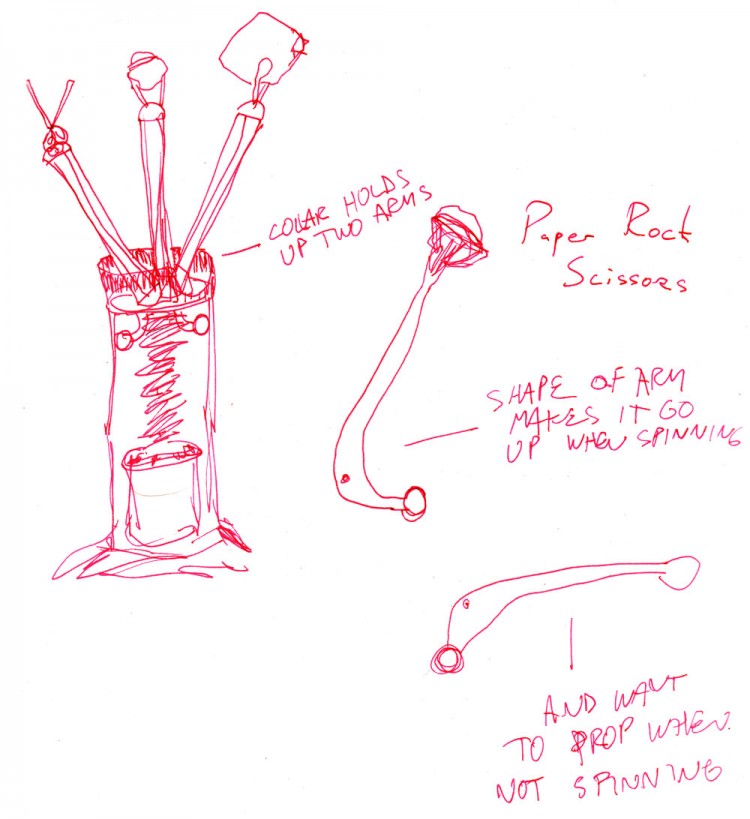I’m participating in Fun-a-Day, a daily art challenge through the month of January, committed to do a daily post here detailing some Big Art Idea or project that looms somewhere out in my future.
As you well know, I have a special affection for art that is in the realm of the Barely Controlled and Not-Quite Completely Safe. Art that in the mere viewing of, you take your life into your own hands. In that category is Rock Paper Scissors.
What’s not to like? Dervishly spinning arms holding razor sharp scissors, a heavy stone, and flapping piece of paper?
I don’t know if I am a genius enough mechanical engineer to design it so that the up-and-down arm balancing works only by spinning and stopping. But I can always consult with people smarter than me on these matters.
I love this. I can see it spinning and visitors squinting and half-shielding their faces the way people do when someone is trying to smash a ball-bearing with a hammer. I can imagine the -KA-CLUNK!- when the chosen arm falls into position. I can imagine building more than one so they can compete roshambo against each other.






I think your design is onto the right solution. Spinning seems necessary. A way of selecting only one element (a slotted collar) likewise seems necessary. The spinning base would have to rise (slowly, building up audience fear) until the arms got near enough to the top for one to want to rotate outward, catch the gentle slope of the collar and ker-chunk. You’d need to somehow stop the rotation quickly (I wonder if there are stepper motors that can spin fairly fast?)
You’d want to keep the diameter of the base as small as possible. That’s too bad, because it would also be fun to implement the fuller version: rock-paper-scissors-lizard-Spock.
So are you imagining that they rise when it is spinning, and fall when it is stopped?
Yes. The platform will rise while spinning, stop (rotation and rise) when a (rock|paper|scissors) engages the slot and presents itself to the participant. Then the platform would lower (still no longer spinning) and the device would reset for another go. The trick would be getting the rotation to stop quickly against the angular momentum. I’m sure there are industrial stepper motors that can do that, but I’m just unsure if they would have a fast enough spin to give the dervish quality you’re hoping for.
Another thought. If the moving components and cylinder were sturdy enough, it’s possible that the machine could violently stop itself each time. You’d need a circuit to monitor the load on the spin motor to cut power quickly. But momentum would be the big question.
It’s fun to think about those arms spinning/rattling in the cylinder getting higher and higher until one arm frees itself and drops down.
How were you imagining the cylinder rose? Some use of centrifugal force? I was imagining the whole thing pretty low tech, but cleverly designed to use the motor, balance, centrifugal force, and design to provide the needed movement.
Actually, the cylinder would remain stationary. The inner platform with its three arms would rotate and the entire platform (inside the stationary cylinder) would rise up inside the cylinder. The reason I’m thinking the inner mechanism would have to rise up is that it would make the design of the arm(s) much easier.
How would that work without having another motor or mechanism? My goal is to have just one motor.
With one motor, there would have to be another way of ‘trapping’ one of the arms to make a selection. That’s why I was thinking of it rotating -and- rising, because once it got high enough a choice would be made.
I was thinking that when power was removed as it slowed the arms would lower until one was captured by the slot. But that begs the question of how it ever gets spinning again.
Right, because the one captured by the slot would presumably prevent any rotation and you’d need a human assistance to get it in position so that spinning would be possible. Definitely why I was thinking the inner platform would have the ability to go up and down because it could reset itself for the next participant.
If there were an inner or outer collar without a slot, that would bring all of the arms up prepared for spinning. Alternately, the notch could be designed with a catch to get one arm that dropped as soon as there was no movement.
The pivot for each arm becomes tricky, because the payload at the end of each arm is so different (heavy stone vs fairly light scissors vs negligible paper.)
True, I think they would have to be counterbalanced appropriately.
The other mechanism I was pondering was to remove the spin and somehow launch the three arms up. Then figure out a way of catching one of the arms. But then I was back to the issue of resetting the unit without manual intervention. Plus, I love the visual of the three arms spinning around before the final choice.
Oh yeah, they gotta spin.
I like your idea of trying to keep it simple, but by having the unit choose an arm during spin-down probably means that the final choice will be slow. I wish we could grab an arm violently without a human being able to see it. Hmm. I wonder if an electromagnet could be used to capture an arm… I’ve never tried making an electromagnetic using anything higher than 12VDC. I wonder what 120VDC would do…?
An electromagnet is an interesting idea. That gives more control of the “grabbing” process, and it could be a solution to the “notch” that allows an arm to be caught as well as easily released.
I don’t know if you’ve got some really beefy diodes laying around and enough wire for about 8 ohms of resistance, but a 120VDC electromagnet is possible.